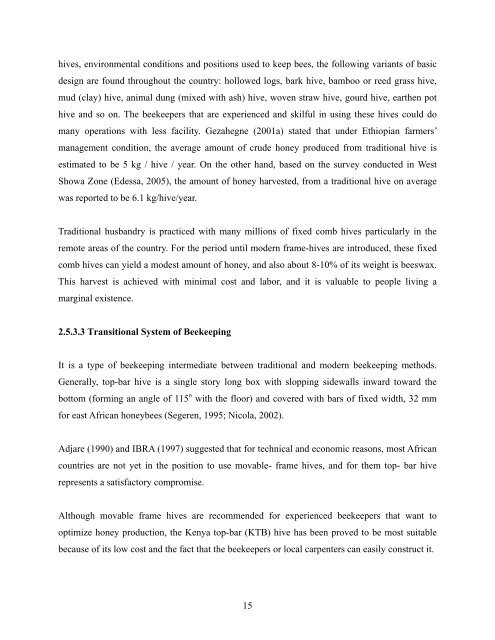Honeybee Production and Marketing Systems, Constraints - IPMS ...
Honeybee Production and Marketing Systems, Constraints - IPMS ...
Honeybee Production and Marketing Systems, Constraints - IPMS ...
- No tags were found...
You also want an ePaper? Increase the reach of your titles
YUMPU automatically turns print PDFs into web optimized ePapers that Google loves.
hives, environmental conditions <strong>and</strong> positions used to keep bees, the following variants of basicdesign are found throughout the country: hollowed logs, bark hive, bamboo or reed grass hive,mud (clay) hive, animal dung (mixed with ash) hive, woven straw hive, gourd hive, earthen pothive <strong>and</strong> so on. The beekeepers that are experienced <strong>and</strong> skilful in using these hives could domany operations with less facility. Gezahegne (2001a) stated that under Ethiopian farmers’management condition, the average amount of crude honey produced from traditional hive isestimated to be 5 kg / hive / year. On the other h<strong>and</strong>, based on the survey conducted in WestShowa Zone (Edessa, 2005), the amount of honey harvested, from a traditional hive on averagewas reported to be 6.1 kg/hive/year.Traditional husb<strong>and</strong>ry is practiced with many millions of fixed comb hives particularly in theremote areas of the country. For the period until modern frame-hives are introduced, these fixedcomb hives can yield a modest amount of honey, <strong>and</strong> also about 8-10% of its weight is beeswax.This harvest is achieved with minimal cost <strong>and</strong> labor, <strong>and</strong> it is valuable to people living amarginal existence.2.5.3.3 Transitional System of BeekeepingIt is a type of beekeeping intermediate between traditional <strong>and</strong> modern beekeeping methods.Generally, top-bar hive is a single story long box with slopping sidewalls inward toward thebottom (forming an angle of 115 o with the floor) <strong>and</strong> covered with bars of fixed width, 32 mmfor east African honeybees (Segeren, 1995; Nicola, 2002).Adjare (1990) <strong>and</strong> IBRA (1997) suggested that for technical <strong>and</strong> economic reasons, most Africancountries are not yet in the position to use movable- frame hives, <strong>and</strong> for them top- bar hiverepresents a satisfactory compromise.Although movable frame hives are recommended for experienced beekeepers that want tooptimize honey production, the Kenya top-bar (KTB) hive has been proved to be most suitablebecause of its low cost <strong>and</strong> the fact that the beekeepers or local carpenters can easily construct it.15
















